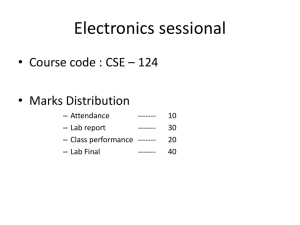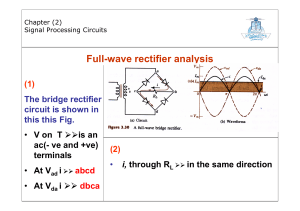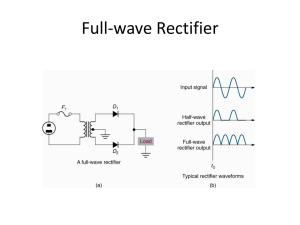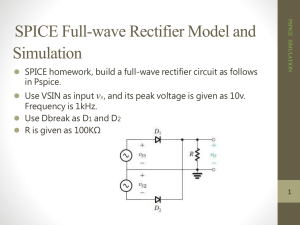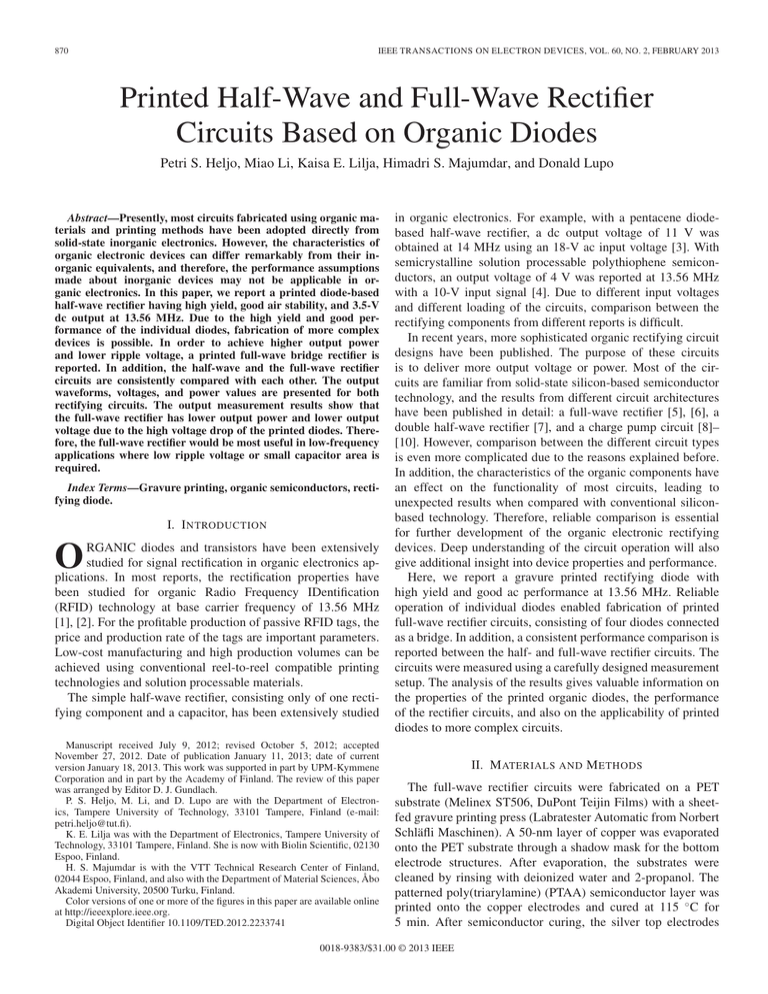
870
IEEE TRANSACTIONS ON ELECTRON DEVICES, VOL. 60, NO. 2, FEBRUARY 2013
Printed Half-Wave and Full-Wave Rectifier
Circuits Based on Organic Diodes
Petri S. Heljo, Miao Li, Kaisa E. Lilja, Himadri S. Majumdar, and Donald Lupo
Abstract—Presently, most circuits fabricated using organic materials and printing methods have been adopted directly from
solid-state inorganic electronics. However, the characteristics of
organic electronic devices can differ remarkably from their inorganic equivalents, and therefore, the performance assumptions
made about inorganic devices may not be applicable in organic electronics. In this paper, we report a printed diode-based
half-wave rectifier having high yield, good air stability, and 3.5-V
dc output at 13.56 MHz. Due to the high yield and good performance of the individual diodes, fabrication of more complex
devices is possible. In order to achieve higher output power
and lower ripple voltage, a printed full-wave bridge rectifier is
reported. In addition, the half-wave and the full-wave rectifier
circuits are consistently compared with each other. The output
waveforms, voltages, and power values are presented for both
rectifying circuits. The output measurement results show that
the full-wave rectifier has lower output power and lower output
voltage due to the high voltage drop of the printed diodes. Therefore, the full-wave rectifier would be most useful in low-frequency
applications where low ripple voltage or small capacitor area is
required.
Index Terms—Gravure printing, organic semiconductors, rectifying diode.
I. I NTRODUCTION
O
RGANIC diodes and transistors have been extensively
studied for signal rectification in organic electronics applications. In most reports, the rectification properties have
been studied for organic Radio Frequency IDentification
(RFID) technology at base carrier frequency of 13.56 MHz
[1], [2]. For the profitable production of passive RFID tags, the
price and production rate of the tags are important parameters.
Low-cost manufacturing and high production volumes can be
achieved using conventional reel-to-reel compatible printing
technologies and solution processable materials.
The simple half-wave rectifier, consisting only of one rectifying component and a capacitor, has been extensively studied
Manuscript received July 9, 2012; revised October 5, 2012; accepted
November 27, 2012. Date of publication January 11, 2013; date of current
version January 18, 2013. This work was supported in part by UPM-Kymmene
Corporation and in part by the Academy of Finland. The review of this paper
was arranged by Editor D. J. Gundlach.
P. S. Heljo, M. Li, and D. Lupo are with the Department of Electronics, Tampere University of Technology, 33101 Tampere, Finland (e-mail:
petri.heljo@tut.fi).
K. E. Lilja was with the Department of Electronics, Tampere University of
Technology, 33101 Tampere, Finland. She is now with Biolin Scientific, 02130
Espoo, Finland.
H. S. Majumdar is with the VTT Technical Research Center of Finland,
02044 Espoo, Finland, and also with the Department of Material Sciences, Åbo
Akademi University, 20500 Turku, Finland.
Color versions of one or more of the figures in this paper are available online
at http://ieeexplore.ieee.org.
Digital Object Identifier 10.1109/TED.2012.2233741
in organic electronics. For example, with a pentacene diodebased half-wave rectifier, a dc output voltage of 11 V was
obtained at 14 MHz using an 18-V ac input voltage [3]. With
semicrystalline solution processable polythiophene semiconductors, an output voltage of 4 V was reported at 13.56 MHz
with a 10-V input signal [4]. Due to different input voltages
and different loading of the circuits, comparison between the
rectifying components from different reports is difficult.
In recent years, more sophisticated organic rectifying circuit
designs have been published. The purpose of these circuits
is to deliver more output voltage or power. Most of the circuits are familiar from solid-state silicon-based semiconductor
technology, and the results from different circuit architectures
have been published in detail: a full-wave rectifier [5], [6], a
double half-wave rectifier [7], and a charge pump circuit [8]–
[10]. However, comparison between the different circuit types
is even more complicated due to the reasons explained before.
In addition, the characteristics of the organic components have
an effect on the functionality of most circuits, leading to
unexpected results when compared with conventional siliconbased technology. Therefore, reliable comparison is essential
for further development of the organic electronic rectifying
devices. Deep understanding of the circuit operation will also
give additional insight into device properties and performance.
Here, we report a gravure printed rectifying diode with
high yield and good ac performance at 13.56 MHz. Reliable
operation of individual diodes enabled fabrication of printed
full-wave rectifier circuits, consisting of four diodes connected
as a bridge. In addition, a consistent performance comparison is
reported between the half- and full-wave rectifier circuits. The
circuits were measured using a carefully designed measurement
setup. The analysis of the results gives valuable information on
the properties of the printed organic diodes, the performance
of the rectifier circuits, and also on the applicability of printed
diodes to more complex circuits.
II. M ATERIALS AND M ETHODS
The full-wave rectifier circuits were fabricated on a PET
substrate (Melinex ST506, DuPont Teijin Films) with a sheetfed gravure printing press (Labratester Automatic from Norbert
Schläfli Maschinen). A 50-nm layer of copper was evaporated
onto the PET substrate through a shadow mask for the bottom
electrode structures. After evaporation, the substrates were
cleaned by rinsing with deionized water and 2-propanol. The
patterned poly(triarylamine) (PTAA) semiconductor layer was
printed onto the copper electrodes and cured at 115 ◦ C for
5 min. After semiconductor curing, the silver top electrodes
0018-9383/$31.00 © 2013 IEEE
HELJO et al.: HALF- AND FULL-WAVE RECTIFIER CIRCUITS BASED ON ORGANIC DIODES
871
Fig. 2. (a) Half-wave rectifier circuit. (b) Current pathway in a halfwave rectifier during the positive input cycle. (c) Full-wave rectifier circuit.
(d) Current pathway in a full-wave rectifier during the positive input cycle. UD1
and UD2 are voltage drops over the printed diodes, and UR is the voltage drop
over the load resistor.
Fig. 1. (a) Photo of the measurement setup used in half-wave rectifier measurements. (b) Photo of the printed full-wave circuit, including four diodes,
where the semiconductor is sandwiched between the Cu and Ag electrodes.
(c) Simplest equivalent circuit for an organic diode with no contact effects,
where R (10 kΩ) describes the bulk resistance of the diode and C (71 pF)
describes the diode geometric capacitance.
were gravure printed using silver flake ink (PM460A from
Acheson Industries Ltd.). The ink was cured at 115 ◦ C for
5 min. All the fabrication steps were performed in a dust-free
environment at room temperature and in ambient air. A photo
of the full-wave circuit is presented in Fig. 1(b). For the halfwave rectifier measurements, individual diodes were separated
from the full-wave circuits, thus ensuring comparable device
operation. Mechanism of operation of the diodes is described
in [11] and [12], including detailed information about the diode
rectification and charge injection properties.
PTAA is known to be a stable semiconductor material in
ambient air [13]. Therefore, all the measurements and characterization were performed in ambient laboratory conditions. In
addition, the samples were stored in ambient air for one month
before the measurements. The results are average values from
three different samples. The thickness of the semiconductor
layer was calculated based on the diode cross-sectional area
(optical microscope Olympus BX51) and measured geometric
capacitance at 13.56 MHz (HP Network analyzer 8752A) using
relative permittivity of 3 for the PTAA. A simple equivalent
circuit with no contact effects was also built for the printed
diodes based on the measured geometric capacitance and effective diode resistance estimated from the output power measurements [see Fig. 1(c)]. A 10-V sinusoidal input (Keithley
3390) and a 4.7-nF discrete load capacitor CL were used in all
rectifier output measurements.
A. Output Voltage
The half- and full-wave measurement circuits are illustrated
in Fig. 2. Measurements were performed using input signal
frequencies between 10 kHz and 40 MHz. The rectified output voltage (RMS) and ripple voltage (peak-to-peak) over the
external 100-kΩ load RL were measured from both circuits
with an oscilloscope (Tektronix DPO4104) using 10× voltage
probes (Tek P6139A from Tektronix). For easier comparison
with earlier reports, the half-wave rectifier output voltage was
also measured in an additional measurement using a 1-MΩ
load. A photo of the measurement setup used in the half-wave
rectifier measurements is presented in Fig. 1(a). For the fullwave rectifier circuit, a different measurement probe was used
due to the different amount of required contact points.
Output voltage waveforms were also measured to ensure
proper function of the circuits. The measurement circuits in
Fig. 2 were used, but the frequency was fixed to 100 Hz to limit
capacitive effects on the resulting waveform.
B. Output Power
Output power as a function of load resistance was measured
for both circuits. Measurements were performed at frequencies
of 10 kHz and 1 MHz using external loads from 1 to 100 kΩ.
Output power was calculated by dividing the square of the
measured RMS output voltage with the output load resistance.
Due to the capacitive nature of the diode, the input impedance
is strongly related to frequency. At frequencies at which the
output ripple voltage is low, the input impedance measurement
would mainly describe the capacitance of the circuit and not
give additional information about the circuit operation.
III. R ESULTS AND D ISCUSSION
Based on the diode geometric capacitance of 71 pF and diode
active area of 0.97 mm2 , the thickness of the printed semiconductor layer was 360 nm. The yield of the individual diodes
was determined by inspecting the output voltage with a 10-V
input at 13.56 MHz. As a result, 31 out of 32 diodes rectified
a constant dc output. Thus, the yield of the individual diodes
was 97%. High yield, good output performance, and reliable
872
IEEE TRANSACTIONS ON ELECTRON DEVICES, VOL. 60, NO. 2, FEBRUARY 2013
Fig. 3. Rectifier output waveforms. The upper and lower figures present the
half- and full-wave rectifier output voltages, respectively. Measurements were
performed at 100 Hz with a 100-kΩ load resistor.
operation of the single diodes at 13.56 MHz enabled the fabrication of more complex devices. Full-wave bridge rectifier
circuits were printed to achieve higher output power and lower
ripple voltage. However, the printed full-wave rectifier performance was strongly affected by the characteristic properties of
the printed diodes. This demonstrates the importance of consistent comparison between the different circuit architectures.
The load capacitor and diode geometric capacitance have an
effect on the output voltage waveform at high frequencies. In
addition, the charge carrier mobility and charge storage phenomenon [14] have a notable effect above 100-kHz frequencies.
However, at low frequencies, the waveforms are easy to identify
and compare. The waveform results at 100 Hz are presented
in Fig. 3. The same input voltage was used for both circuits.
Thus, the differences between half- and full-wave rectification
are easy to observe. The half-wave rectifier output voltage
amplitude was 7.3 V. The voltage drop from the 10-V input is
mainly caused by nonideal metal–semiconductor contacts and
high resistivity of the semiconductor material. The full-wave
rectifier output voltage amplitudes during the positive (4.7-V)
and negative (5.0-V) input cycles have a small difference due to
the small differences between the diode characteristics. These
differences arise mainly from the printing process. The lower
output voltage of the full-wave rectifier can be explained by
the current pathways in Fig. 2. In the full-wave rectifier, the
current has to flow through two diodes and, thus, the voltage
drop caused by the diodes is higher than in the half-wave
rectifier. This explanation corresponds well with solid-state
silicon-based full-wave rectifiers, where in practice the filtered
dc output voltage is the input voltage minus two times the
diode voltage drop. On the other hand, in the half-wave rectifier
circuits, the filtered dc output voltage is in practice the input
voltage minus the voltage drop of a single diode.
The rectified dc output voltages and ripple voltages were
now measured to study the ac rectification differences between
the two filtered circuits (see Fig. 4). The output voltage of the
full-wave rectifier was lower due to the higher voltage drop
over the two diodes, as explained earlier. In addition, the two
diodes in series correspond to a thicker semiconductor layer
Fig. 4. Rectified output and ripple voltages with 10-V ac input. Comparison
between the two circuits was performed using a 100-kΩ load resistor. The halfwave rectifier was measured also with a 1-MΩ load for easier comparison with
previous results.
[see Fig. 2(d)]. This decreases the speed of the device and limits
the output at high frequencies.
In Fig. 4, the advantage of the full-wave rectifier over the
half-wave rectifier can be observed only at low frequencies, at
which the time constant of the load RC circuit and the input
signal period are about the same order of magnitude. For the
half-wave rectifier, the rectified output voltage and the ripple
voltage at 10 kHz were 5.0 V and 1.1 VP −P , respectively,
whereas the output and ripple voltages for the full-wave rectifier
were 3.8 V and 0.44 VP −P , respectively. Therefore, at 10 kHz,
the relative amount of ripple voltage in the full-wave rectifier
output is half of the amount of ripple in the half-wave rectifier
output. At higher frequencies (>100 kHz), the ripple of the
half-wave rectifier circuit decreases to near the same level as
that of the full-wave rectifier. After this point, the full-wave
rectifier is no longer practical due to the slower speed of the
device and lower output voltages.
The half-wave rectifier output voltage measurement with a
1-MΩ load resistor can be compared with previously published
results [4], [15]. However, as noted before, the comparison
is not easy due to the different measurement parameters and
measurement conditions. With a 1-MΩ load, the rectified output
voltage of the half-wave rectifier was 3.5 V at 13.56 MHz.
Higher output voltages can be also obtained by printing thinner semiconductor layers. However, the yield of the process
decreases when the semiconductor layer thickness is reduced
below 360 nm. The high yield is of great importance while
designing and manufacturing complex devices in a reel-to-reel
process.
To estimate the device performance in different applications,
the rectified output power was measured as a function of load
resistance (see Fig. 5). For the half-wave rectifier circuit, a
maximum output power value of 0.58 mW was obtained below
10-kΩ loads, and for the full-wave rectifier circuit, a maximum
output power value of 0.17 mW was achieved using a 50-kΩ
load resistor. The effective resistance of the device was estimated to be equal to the load resistance when the output
power is at maximum. For the single diode in the half-wave
rectifier configuration, the effective resistance is in the range of
HELJO et al.: HALF- AND FULL-WAVE RECTIFIER CIRCUITS BASED ON ORGANIC DIODES
873
balance between the charge consumed by the load resistor RL
during one input signal period and charge delivered by the
current flow through the diode during the positive input signal
cycle (2). Leakage current through the diode is assumed to be
insignificant
VDC 2π
=
RL ω
t2
Idiode_forward dt
(2)
t1
where t1 and t2 delimit the forward bias time interval, and
Idiode_forward is described by the space-charge-limited current
assuming perfect injection of charges [17], [18].
Idiode_forward = A
Fig. 5. Rectifier output power at 10-kHz and 1-MHz frequencies. A 10-V ac
input signal and a 4.7-nF load capacitor were used in the measurements.
10 kΩ. For the full-wave bridge, the effective resistance can be
estimated to be about 50 kΩ.
With low output load resistance, the half-wave rectifier seems
to have significantly lower output power at 1 MHz than at
10 kHz (see Fig. 5). The reason for higher power at 10 kHz
is high ripple voltage due to the low RC time constant of the
load circuit, i.e., the capacitor charges to higher voltage and discharges almost completely during the input signal period. Due
to the high peak values of the output voltage, the average value
of the power increases. With high output load resistances, the
lower output power of the high-frequency signals is expected
due to the limited speed of the devices.
The maximum operation frequency of the circuit is mainly
dependent on the diode charge transport characteristics and the
diode geometric capacitance. Limited charge carrier mobility
has an effect on the output at high frequencies. In addition, the
internal diode capacitance will cause capacitive shunting of the
diode that can be seen as decreased input signal amplitude and
will cause drop on the output voltage [16]. In both half- and
full-wave rectifier measurements, capacitive shunting started to
affect at frequencies above 13.56 MHz.
Traditionally, the maximum operation frequency fmax of the
diode can be estimated based on the diode transit time tT
fmax =
1
μ(VIN − VDC )
=
tT
d2
(1)
where μ is the charge mobility, VIN is the input signal amplitude, VDC is the rectified dc voltage, and d is the thickness of
the semiconductor layer. However, in the transit time model,
the maximum operation frequency is assumed to depend only
on the time that is required for the charge carriers to travel from
one electrode to the other. Therefore, the result is a theoretical
maximum frequency taking into account only the charge carrier
mobility.
For the half-wave rectifier circuit, more sophisticated models
have been developed. Because of high input signal amplitude
and dc output voltages of a few volts, the calculations based
on small-signal parameters are not applicable. However, a
model based on large signal analysis was developed in [3].
The maximum operation frequency is calculated based on the
2
9ε0 εr μVdiode
8d3
(3)
where Vdiode = VIN − VDC , i.e., the voltage over the diode.
The dependence of the output voltage on the load resistance
can be observed from (2). If the resistance of the load is
increased, the output dc voltage will increase until a new balance point is achieved. Conversely, with low resistance values,
higher current flows through the load resistor and higher current
is needed through the diode. If the current supplied by the
diode is not adequate, the output voltage will decrease on the
level where the balance is again reached. Correspondingly,
the charge delivered by the current flow through the diode is
frequency dependent due to the limited mobility of the charge
carriers. Therefore, the maximum operation frequency is also
dependent on the load resistance.
To solve the maximum frequency limit, quite rough assumptions have to be made. Some of the assumptions are
not completely applicable for the printed diodes in this paper.
Therefore, the frequency dependence based on the large-signal
analysis is not presented here. The solved equations and assumptions are presented in detail in [3].
IV. C ONCLUSION
Air-stable half- and full-wave rectifier circuits have been
fabricated using solution processable organic materials and
reel-to-reel compatible gravure printing process. The circuit
fabrication method enabled consistent comparison between
the two rectifying circuits. For the half-wave rectifier, high
yield and a 3.5-V dc output at 13.56 MHz were presented.
The output voltage measurement showed that the full-wave
rectifier is useful in low-frequency applications where low
ripple voltage and small capacitor area are required. The output
power measurements further showed the higher output power
of the half-wave rectifier. By increasing the load resistance, the
voltage drop over the diodes could be reduced and higher output
voltages could be obtained. However, this neither increases
the output power nor correlates with many applications. These
results demonstrate important differences between inorganic
and organic device operations. Due to the output characteristics,
the full-wave rectifier is suitable for limited applications only.
However, the full-wave rectifier circuit illustrates the possibility
to manufacture more complex air-stable devices using high
throughput processes.
874
IEEE TRANSACTIONS ON ELECTRON DEVICES, VOL. 60, NO. 2, FEBRUARY 2013
R EFERENCES
[1] M. Jung, J. Kim, J. Noh, N. Lim, C. Lim, G. Lee, J. Kim, H. Kang,
K. Jung, A. D. Leonard, J. M. Tour, and G. Cho, “All-printed and rollto-roll-printable 13.56-MHz-operated 1-bit RF tag on plastic foils,” IEEE
Trans. Electron Devices, vol. 57, no. 3, pp. 571–580, Mar. 2010.
[2] S. Steudel, S. D. Vusser, K. Myny, M. Lenes, J. Genoe, and P. Heremans,
“Comparison of organic diode structures regarding high-frequency rectification behavior in radio-frequency identification tags,” J. Appl. Phys.,
vol. 99, no. 11, pp. 114 519-1–114 519-7, Jun. 2006.
[3] S. Steudel, K. Myny, V. Arkhipov, C. Deibel, S. D. Vusser, J. Genoe, and
P. Heremans, “50 MHz rectifier based on an organic diode,” Nat. Mater.,
vol. 4, no. 8, pp. 597–600, Aug. 2005.
[4] C.-Y. Lin, C.-H. Tsai, H.-T. Lin, L.-C. Chang, Y.-H. Yeh, Z. Pei,
Y.-R. Peng, and C.-C. Wu, “High-frequency polymer diode rectifiers
for flexible wireless power-transmission sheets,” Org. Electron., vol. 12,
no. 11, pp. 1777–1782, Nov. 2011.
[5] R. Rotzoll, S. Mohapatra, V. Olariu, R. Wenz, M. Grigas, and K. Dimmler,
“Radio frequency rectifiers based on organic thin-film transistors,” Appl.
Phys. Lett., vol. 88, no. 12, pp. 123 502-1–123 502-3, Mar. 2006.
[6] D.-H. Lee, J.-M. Kim, J.-W. Lee, and Y.-S. Kim, “Improved organic rectifier using polymethyl-methacrylate-poly 4-vinylphenol double layer,”
Micro Nano Lett., vol. 6, no. 7, pp. 567–570, Jul. 2011.
[7] K. Myny, S. Steudel, P. Vicca, J. Genoe, and P. Heremans, “An integrated
double half-wave organic Schottky diode rectifier on foil operating at
13.56 MHz,” Appl. Phys. Lett., vol. 93, no. 9, pp. 093305-1–093305-3,
Sep. 2008.
[8] E. Cantatore, T. C. T. Geuns, G. H. Gelinck, E. van Veenendaal, A. F. A.
Gruijthuijsen, L. Schrijnemakers, S. Drews, and D. M. de Leeuw, “A
13.56-MHz RFID system based on organic transponders,” IEEE J. SolidState Circuits, vol. 42, no. 1, pp. 84–92, Jan. 2007.
[9] S. Mutlu, I. Haydaroglu, and A. O. Sevim, “Realization of polymer charge
pump circuits using polymer semiconductors,” Org. Electron., vol. 12,
no. 2, pp. 312–321, Feb. 2011.
[10] P. Heljo, K. E. Lilja, S. Tuukkanen, and D. Lupo, “Charge pump circuit
using printed organic diodes and capacitors,” in Proc. LOPE-C, Frankfurt,
2011, pp. 53–55.
[11] K. E. Lilja, H. S. Majumdar, F. S. Petterson, R. Österbacka, and
T. Joutsenoja, “Enhanced performance of printed organic diodes using a
thin interfacial barrier layer,” ACS Appl. Mater. Interf., vol. 3, pp. 7–10,
Dec. 2010.
[12] K. E. Lilja, H. S. Majumdar, K. Lahtonen, P. Heljo, S. Tuukkanen,
T. Joutsenoja, M. Valden, R. Österbacka, and D. Lupo, “Effect of dielectric barrier on rectification, injection and transport properties of printed
organic diodes,” J. Phys. D, Appl. Phys., vol. 44, no. 29, p. 295 301,
Jul. 2011.
[13] W. Zhang, J. Smith, R. Hamilton, M. Heeney, J. Kirkpatrick, K. Song,
S. E. Watkins, T. Anthopoulos, and I. McCulloch, “Systematic improvement in charge carrier mobility of air stable triarylamine copolymers,”
J. Am. Chem. Soc., vol. 131, no. 31, pp. 10 814–10 815, Jul. 2009.
[14] B. G. Streetman and S. K. Banerjee, Solid State Electronic Devices,
6th ed. Upper Saddle River, NJ: Pearson Prentice Hall, 2005, pp. 208–211.
[15] K. E. Lilja, T. G. Bäcklund, D. Lupo, T. Hassinen, and T. Joutsenoja,
“Gravure printed organic rectifying diodes operating at high frequencies,”
Org. Electron., vol. 10, no. 5, pp. 1011–1014, Aug. 2009.
[16] Y. Ai, S. Gowrisanker, H. Jia, I. Trachtenberg, E. Voge, R. M. Wallace,
B. E. Gnade, R. Barnett, H. Stiegler, and H. Edwards, “14 MHz organic
diodes fabricated using photolithographic processes,” Appl. Phys. Lett.,
vol. 90, no. 26, pp. 262 105-1–262 105-3, Jun. 2007.
[17] A. Rose, “Space-charge-limited currents in solids,” Phys. Rev., vol. 97,
no. 6, pp. 1538–1544, Mar. 1955.
[18] M
.A
. Lampert, “Simplified theory of space-charge-limited currents in an in
sulator with traps,” Phys. Rev., vol. 103, no. 6, pp. 1648–1656, Sep. 1956.
Petri S. Heljo received the M.Sc. degree in biological and chemical measurements from Tampere University of Technology, Tampere, Finland, in 2010.
He is currently with the Department of Electronics, Tampere University of Technology.
Miao Li received the M.Sc. degree in radio frequency electronics from Tampere University of
Technology, Tampere, Finland, in 2010.
Since 2011, she has been a Research Engineer in
the Department of Electronics, Tampere University
of Technology.
Kaisa E. Lilja received the D.Sc. (Tech.) degree
from Tampere University of Technology, Tampere,
Finland, in 2011.
She is currently an Application Specialist at Biolin
Scientific, Espoo, Finland.
Himadri S. Majumdar received the Ph.D. degree in
science from Jadavpur University, Kolkata, India.
He is a Senior Scientist at the VTT Technical
Research Center of Finland, Espoo, Finland, and
an Adjunct Professor at Åbo Akademi University,
Turku, Finland.
Donald Lupo received the Ph.D. degree in physical
chemistry from Indiana University, Bloomington.
He is currently a Professor of electronic materials
in the Department of Electronics, Tampere University of Technology, Tampere, Finland.


